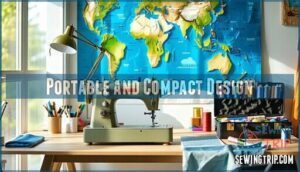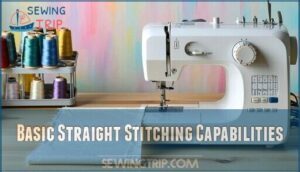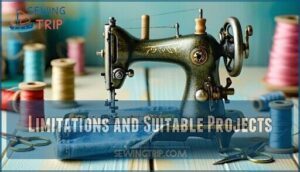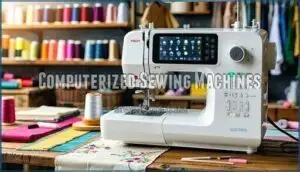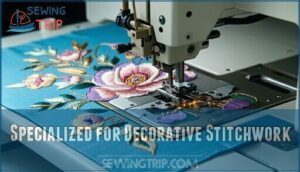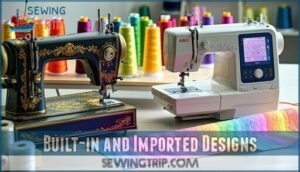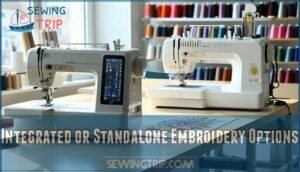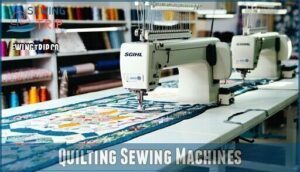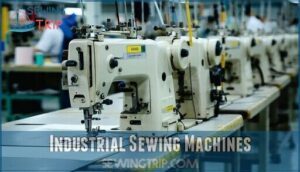This site is supported by our readers. We may earn a commission, at no cost to you, if you purchase through links.
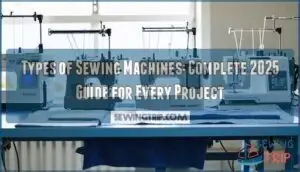
Domestic machines handle everyday sewing with versatile stitch options, while mini machines offer portability for quick repairs.
Computerized models bring automation and precision to complex work, embroidery machines specialize in decorative stitching, and quilting machines tackle thick, layered materials with ease.
Industrial machines power through heavy-duty commercial tasks that would overwhelm household models.
Understanding these categories helps you match the right machine to your creative vision, whether you’re hemming curtains or launching a fashion line.
Each type offers unique features that can transform your sewing experience.
Table Of Contents
Key Takeaways
- You’ll need different machines for different projects – domestic machines handle everyday sewing, while industrial machines power through heavy materials like leather that would break household models.
- Computerized machines offer the most versatility – they provide hundreds of built-in stitches, automatic threading, LCD screens, and can import custom embroidery designs via USB.
- Portable mini machines work great for basic repairs – they’re perfect for travel and quick fixes, but can’t handle thick fabrics or complex projects like full-sized machines.
- Specialized machines excel at specific tasks – quilting machines handle thick layered materials, embroidery machines create intricate decorative work, and sergers finish edges professionally.
Domestic Sewing Machines
When you’re starting your sewing journey, domestic machines offer the perfect balance of functionality and affordability for home projects.
These versatile workhorses handle everything from basic repairs to complex garments with features like adjustable stitch length, multiple stitch patterns, and user-friendly controls that won’t overwhelm beginners.
From simple repairs to complex creations, these machines master every stitch with beginner-friendly precision.
Basic Features and Functions
Basic domestic sewing machines offer essential features that make everyday sewing straightforward.
You’ll find adjustable stitch length for different fabric weights, reliable feed dogs that guide material smoothly, and tension control for balanced stitches.
Most machines include bobbin winding systems and interchangeable presser feet for various tasks.
These core sewing machine features handle straight seams, zigzag stitches, and buttonholes efficiently.
Straight, Zig-zag, and Decorative Stitches
Most domestic sewing machines offer three core stitch types that’ll handle your projects with precision.
Straight stitches work best on woven fabrics, reaching speeds up to 1,600 stitches per minute with adjustable stitch length up to 7mm.
Zig-zag stitches tackle stretch fabrics and prevent fraying—you can adjust both width and length for different fabric compatibility needs.
Decorative stitches transform plain fabric into custom designs, with modern machines offering up to 80 built-in patterns.
For example, you can use zigzag stitches for finishing raw edges to prevent unraveling.
Proper tension adjustment prevents puckering on delicate materials, while matching needle types to your fabric guarantees clean results.
Different sewing machine types excel at specific stitch applications.
Suitable for Various Projects
You’ll discover domestic sewing machines excel at tackling everything from simple alterations to complex garments.
These versatile workhorses handle various fabric types and project complexity levels, making them perfect for beginners and experienced sewers alike. Machine versatility depends on stitch options, while budget considerations affect available features across different sewing machine types.
- Mending torn jeans – that satisfying moment when you save your favorite pair
- Creating custom curtains – transforming your space with personal style
- Crafting baby clothes – stitching love into tiny garments
- Designing Halloween costumes – bringing creative visions to life
- Hemming formal wear – achieving that perfect professional fit
Domestic sewing machines offer remarkable fabric compatibility, from delicate silks to sturdy denims. Your skill level determines which features you’ll use most, though these machines grow with your abilities.
Unlike industrial sewing machines built for single purposes, domestic models provide the flexibility modern sewers need for diverse projects.
Electronic Vs Mechanical Options
When choosing between mechanical sewing machines and electronic machines, consider stitch control precision and motor power capabilities.
Mechanical vs computerized sewing machine technology offers distinct advantages, with electronic machines providing advanced feature sets with LCD displays, automatic threading, and extensive stitch libraries.
Electronic machines deliver advantages in stitch consistency and programmable functions, while mechanical sewing machines offer simplicity through manual knobs and dials.
Cost comparison reveals mechanical options cost less upfront with lower repair complexity, however, electronic machines excel in areas that require high automation and complexity, and your choice depends on budget, desired automation level, and project complexity among different sewing machine types.
Mini and Portable Sewing Machines
Mini and portable sewing machines offer the perfect solution when you need basic stitching capabilities without the bulk of a full-sized machine.
These compact devices handle simple repairs, alterations, and lightweight projects, though they can’t match the power and versatility of their larger counterparts.
Portable and Compact Design
With Travel Sewing in mind, mini sewing machines excel at portability without sacrificing functionality.
These Lightweight Machines fit perfectly in your travel bag, making them ideal for on-the-go repairs and projects.
- Space Saving: Compact design fits in small storage areas
- Easy Storage: Weighs typically 2-8 pounds for effortless transport
- On-the-Go: Battery operation eliminates cord dependency
A portable sewing machine transforms any location into your workspace.
Whether you’re attending sewing classes or handling emergency repairs during travel, these domestic sewing machine types deliver convenience.
Many users find that miniature sewing devices are particularly useful.
Their sewing machine portability makes them perfect companions for crafters who refuse to leave their creativity behind.
Basic Straight Stitching Capabilities
Mini machines excel at basic straight stitching with adjustable stitch length and thread tension controls.
You’ll find needle selection matters for fabric compatibility, though options remain limited compared to domestic sewing machine types.
These lockstitch machines handle lightweight fabrics well, creating clean seam finishes on simple projects.
While industrial sewing machine power isn’t available, portability makes them perfect for quick repairs and basic alterations. Many models also offer automatic thread tension for consistent stitch quality.
Limitations and Suitable Projects
Despite their convenience, portable sewing machines come with significant fabric limitations and project complexity constraints.
You’ll find these compact units struggle with thick materials like denim or canvas, making them unsuitable for heavy-duty projects.
Here’s what works best:
- Light fabric repairs – cotton shirts, thin linens
- Small crafting projects – doll clothes, simple bags
- Emergency mending – quick fixes on vacation
- Basic alterations – hemming lightweight garments
Your skill level won’t matter much since these domestic sewing machine alternatives offer limited functionality compared to industrial sewing machine capabilities.
Considering their limitations, it’s important to understand portable sewing constraints before starting a project.
Machine lifespan stays reasonable with proper care, though repair costs can exceed the unit’s value, making replacement more practical than fixing.
Computerized Sewing Machines
You’ll find computerized sewing machines are the most sophisticated option available, featuring LCD screens, automatic threading, and hundreds of built-in stitches that adjust themselves based on your fabric choice.
These machines can import custom designs via USB ports and often include embroidery capabilities, making them perfect for sewers who want professional results without the guesswork, utilizing hundreds of built-in stitches.
Advanced Features and Automation
Modern computerized sewing machines pack serious tech power into your sewing room.
Automated Threading systems eliminate the frustration of threading needles manually, while Stitch Regulation maintains consistent stitch quality regardless of your hand speed.
Advanced Sensor Technology monitors fabric thickness and automatically adjusts presser foot pressure.
Pattern Recognition software identifies your fabric type and recommends ideal settings.
Some models even handle Smart Fabrics with specialized programming.
Your computerized sewing machine becomes a precision instrument through sewing machine automation, processing complex calculations in milliseconds.
Built-in sewing machine software manages hundreds of stitch combinations, while sewing machine connectivity links you to online pattern libraries.
These machines offer various product options for different needs.
These electronic sewing machines transform tedious manual adjustments into one-touch operations, letting you focus on creativity rather than mechanics.
LCD Screens and Automatic Functions
LCD screens on computerized sewing machines transform your sewing experience with intuitive touchscreen interfaces that display stitch patterns, settings, and real-time adjustments.
These screens offer extensive screen customization options, allowing you to personalize layouts and access frequently used functions quickly.
Stitch automation features automatically adjust tension, speed, and feed based on selected patterns, while built-in error messages guide you through common issues like threading problems or needle changes.
Though function complexity might seem overwhelming initially, most machines include helpful tutorials and software updates that enhance performance and add new capabilities.
These sewing machine innovations represent significant sewing machine advancements over traditional electronic sewing machines, making computerized sewing machine features more accessible than ever, with a focus on real-time adjustments.
Wide Range of Stitches, Including Embroidery
When you access a computerized sewing machine’s stitch library, you’ll discover hundreds of creative possibilities.
These machines typically offer 70-351 built-in patterns, from basic utility stitches to complex decorative motifs.
Your embroidery machine capabilities include:
- Stitch Complexity ranging from simple straight lines to intricate alphanumeric designs
- Design Software compatibility for importing custom embroidery designs via USB
- Thread Types optimization across cotton, polyester, and specialty materials
Advanced computerized sewing machines handle Pattern Digitizing seamlessly, letting you transform ideas into stitched reality.
The market is influenced by key technological advancements, driving innovation.
Various sewing machine feet expand your sewing techniques, while built-in Project Ideas inspire everything from monogramming to appliqué work.
Custom Program Import Options
You’ll expand your computerized sewing machine’s creative potential through custom program imports.
Most machines accept embroidery files via USB Transfer Methods or Memory Card Options.
Popular formats include DST, PES, and JEF files.
Design Software Compatibility varies by brand, so check your embroidery machine’s supported formats.
Some newer models offer Cloud Integration for seamless downloading, which can further enhance your machine’s capabilities with custom program imports.
Embroidery Machines
If you’re looking to add professional decorative touches to your sewing projects, embroidery machines are your go-to solution for creating intricate designs with precision and speed.
These specialized machines come as either standalone units dedicated solely to embroidery or combination sewing-embroidery models that handle both regular stitching and decorative work.
Specialized for Decorative Stitchwork
Embroidery machines transform your sewing projects into artistic masterpieces with specialized decorative stitchwork capabilities.
Transform ordinary fabric into breathtaking art with precision stitching that elevates every project beyond simple sewing.
These machines excel at creating intricate patterns that regular sewing can’t achieve.
Key features include:
- Decorative Threads – Metallic, rayon, and specialty threads create stunning fabric effects
- Stitch Patterns – Hundreds of built-in embroidery designs from florals to monograms
- Needle Types – Specialized embroidery needles prevent thread shredding and skipped stitches
- Stabilizers – Essential backing materials keep fabric taut during detailed stitching
- Computerized Controls – Precise stitch placement and automatic thread cutting
Your embroidery machine handles complex decorative stitches that would be impossible manually, letting you personalize everything from clothing to home décor with professional-quality results.
Built-in and Imported Designs
Design origins matter when choosing between built-in and imported patterns.
Modern sewing machines offer 150-1,858 built-in designs including alphabets and seasonal motifs.
Pattern storage expands through USB imports supporting formats like.PES and.DST.
Customization options include resizing and editing designs before stitching.
Software updates enhance stitch variety across domestic sewing machine brands.
Test imported designs first to verify quality compatibility with your machine types.
Integrated or Standalone Embroidery Options
Should you invest in a standalone embroidery machine or choose an integrated computerized sewing machine? Your decision depends on project scale and workspace constraints.
- Design Complexity – Integrated machines handle intricate patterns while maintaining standard sewing capabilities
- Software Compatibility – Both options support USB imports for custom designs and professional embroidery formats
- Hoop Size – Standalone units typically offer larger embroidery areas for extensive projects
- Stitch Quality – Advanced tension controls in either configuration guarantee consistent results across various fabrics
Quilting Sewing Machines
Quilting sewing machines are purpose-built to handle the unique demands of quilting projects, from thick layered materials to intricate stitching patterns.
Long-arm quilting machines provide the extended workspace you need for large quilts, while standard quilting machines offer specialized features like adjustable presser foot pressure and extended throat space for maneuvering bulky projects.
Designed Specifically for Quilters
Quilting machines transform your creative vision into stunning reality with specialized features that regular sewing machines can’t match.
These powerhouse tools boast expanded throat space size, allowing you to maneuver bulky quilt sandwiches without wrestling fabric through tight spaces.
Advanced fabric feed systems guarantee smooth, consistent stitching across multiple layers, while specialized quilting foot types like walking feet prevent puckering and shifting.
The quilting stitch options range from straight-line to decorative patterns, giving you creative freedom.
Regular quilting machine maintenance keeps your investment running smoothly.
Many quilters pair their machines with sturdy sewing machine tables for ideal workspace ergonomics and project support.
Long-arm Machines for Larger Projects
Long arm sewing machines transform your quilting experience with throat spaces ranging from 18 to 30 inches.
These quilting machine types accommodate king-size projects on quilting frames measuring 10 to 14 feet.
Advanced stitch regulation and tension control guarantee consistent results across any project size.
Professional fabric loading systems keep layers taut while you guide intricate patterns with precision and speed.
Handling Thick and Layered Materials
When working with multiple fabric layers, quilting machines excel through superior needle selection and enhanced thread strength capabilities.
These heavy duty sewing machines feature adjustable foot pressure and variable stitch length settings that prevent puckering.
Machine power combined with walking foot mechanisms guarantees smooth fabric handling through thick batting layers, unlike standard domestic models that struggle with dense materials.
Proper quilting also depends on understanding fabric grain for stability and smooth fabric handling, which is critical for achieving professional results with heavy duty sewing machines.
Industrial Sewing Machines
You’ll find industrial sewing machines are built for continuous heavy-duty operation in professional manufacturing environments, handling materials like leather, canvas, and rubber that would damage domestic machines.
These specialized machines typically perform one specific function exceptionally well, whether it’s creating lockstitches, chainstitches, or specialized seams for mass production.
Heavy-duty Sewing Machines for Mass Production
Industrial model sewing machines deliver unmatched material handling capabilities for professional sewing operations.
You’ll find these powerhouses excel at production speed while maintaining stitch consistency across demanding manufacturing environments.
- Automation Options: Built-in programmable features reduce manual intervention
- Heavy Duty Construction: Motors handle thick materials like leather and canvas continuously
- Specialized Functions: Single-purpose design optimizes specific sewing tasks
These industrial sewing machine types require significant maintenance demands but justify costs through reliability.
Professional sewing facilities depend on their ability to process high volumes efficiently.
Various heavy duty sewing machine models serve different applications, from lockstitch to safety stitch operations.
Specific Functions and Applications
Why choose specialized industrial sewing machines over domestic alternatives?
Material Compatibility drives these decisions—heavy-duty machines handle leather, canvas, and thick fabrics that would break domestic sewing machine needles.
You’ll find cover stitch machines creating professional hems, serger machines overlocking edges, and bar tack machines reinforcing stress points.
Each industrial sewing machine tackles specific Project Complexity with superior Stitch Durability.
Automation Benefits include consistent tension and speed control.
Your User Skill determines which specialized functions you’ll master, from chain stitching seams to blind hemming invisible finishes on professional garments.
Vintage and Antique Sewing Machines
Nostalgia drives many sewers toward vintage sewing machines, where historical value meets timeless craftsmanship.
These collectible models from brands like Singer Featherweight showcase sewing machine history through their cast-iron construction and hand-operated mechanisms.
- Treadle machines operate without electricity using foot power
- Singer Featherweight models remain highly sought-after collectibles
- Hand-operated mechanisms provide complete control over stitching speed
- Restoration tips include cleaning, oiling, and replacing worn parts
- Historical value increases with original accessories and documentation
You’ll find these vintage sewing machines offer superior durability compared to modern plastic counterparts, often lasting over 100 years with proper maintenance.
Some models, like the Turtleback fetch high prices, making them valuable collector’s items.
Frequently Asked Questions (FAQs)
How many types of sewing machines are there?
Don’t put all your eggs in one basket when choosing machines—you’ve got dozens of options available.
Domestic, industrial, electronic, computerized, serger, embroidery, quilting, and specialized machines each serve different purposes and skill levels.
What are the differences between sewing machines?
You’ll find sewing machines differ by power, function, and complexity.
Domestic models handle light fabrics while industrial machines power through heavy materials.
Electronic versions offer multiple stitches; mechanical ones keep things simple and affordable for beginners.
What are the 5 categories of sewing?
Before electricity powered your grandma’s treadle machine, sewing categories emerged: construction sewing builds garments, decorative sewing adds embellishments, mending repairs damaged items, quilting layers fabrics together, and alterations modifies existing clothing for better fit.
What kind of sewing machine should a beginner buy?
You’ll want a basic mechanical or electronic sewing machine with straight and zigzag stitches.
Look for reliable brands like Singer or Brother, focusing on essential features rather than fancy options you won’t use initially.
How do I maintain and clean my sewing machine properly?
Nearly 80% of sewing machine issues stem from improper maintenance, yet regular cleaning prevents most problems.
Clean your machine after every 8-10 hours of use by removing lint, oiling moving parts, and replacing needles regularly for peak performance.
What accessories and feet are must-haves for my sewing machine?
Essential accessories you’ll need include a walking foot for even fabric feeding, zipper foot for closures, buttonhole foot for professional finishing, and seam ripper for corrections.
These tools transform your machine’s versatility.
They are crucial for professional finishing.
What safety precautions should I take when using a sewing machine?
Keep your fingers clear of the needle area and unplug your machine before threading, changing needles, or cleaning.
Always use proper lighting, maintain good posture, and never force fabric through the machine.
What maintenance schedule do sewing machines require?
You’ll need to clean your machine after every 8-10 hours of use, oil it monthly, and schedule professional servicing annually to keep it running smoothly and prevent costly repairs.
How much do different sewing machine types cost?
Like shopping for a car, sewing machine prices vary dramatically by features and power.
Basic mechanical models start around $100, while computerized machines range $300-$1,
Industrial machines cost $1,000-$10,000+ depending on specialization.
Which brands offer the best warranty coverage?
Singer, Brother, and Janome lead warranty coverage, offering 20-25 years on mechanical parts and 1-2 years on electronics.
You’ll find Bernina provides exceptional lifetime support, while Juki backs industrial models with extensive commercial warranties.
Conclusion
Although you might think choosing the right sewing machine is overwhelming with so many options, understanding the different types of sewing machines simplifies your decision-making process substantially.
Each machine type serves distinct purposes, from domestic models that handle everyday repairs to industrial machines that power commercial operations.
You’ll find the perfect match by considering your project requirements, skill level, and budget constraints.
Whether you’re creating quilts, embroidering designs, or running a production line, there’s a specialized machine designed to meet your specific needs and enhance your sewing success, which can be achieved by selecting the right machine for your project requirements.
- https://www.threadedlines.com/blogs/inspiration/different-types-of-sewing-machines
- https://www.superprof.co.uk/blog/types-of-sewing-machines/
- https://www.weldmaster.com/blog/industrial-sewing-machine-guide
- https://topnotchsewvac.com/blogs/sewing-machine-blog/choosing-between-domestic-vs-industrial-sewing-machines
- https://www.vinyltechnology.com/blog/industrial-sewing-machine-features/

